Vines can escape cultivation easily and climb trees. When left to grow undisturbed, these type of vines can cover the trunk and branches completely. Dense ivy leads to rot, restricts sunlight, strangles the tree, and increases weight, causing trees to fall more easily. Here are some of the vines that are commonly seen growing on trees:
- English ivy
- Boston Ivy
- Japanese Honeysuckle
- Wisteria vine
- Butterfly Vine
- Clematis
- Bignonia Capreolata
- Passiflora
- Poison Ivy
- Vanilla pompona
- Cuscuta reflexa
- Cuscuta campestris
- Mistletoes
- Cuscuta gronovii
- Scaldweed
- Chaparral dodder
English Ivy

English ivy is a trailing or climbing vine that can grow to heights of 20 to 80 feet and spread to between 3 and 50 feet. English ivy and its cultivars provide lush groundcovers, and they trail and climb to cover fences, trellises, slopes, banks or walls, though rootlets on their climbing vines can damage the structures and trees they grow on. English ivy grows in two stages: a familiar, juvenile stage in which it usually appears in gardens, and a second, adult stage where it produces flowers in fall and blue-black berries that last throughout the winter.
Boston Ivy
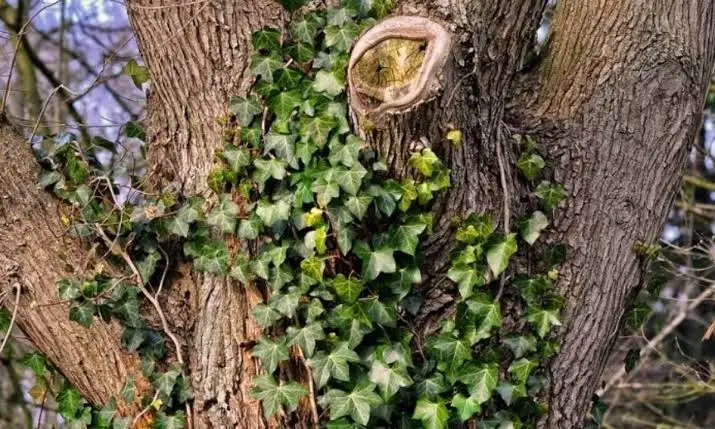
Boston ivy is a deciduous vine that produces flaming fall colors of scarlet and purple as well as blue-black berries that remain on the vine after the leaves drop off. It has a climbing growth habit and can grow as high as 50 feet on trees or other supportive structure on which to grow. Boston ivy can damage not only trees but wood siding, gutters, and even roofing if it is left unsupervised. When removing Boston ivy from trees, do not simply rip the ivy off the tree. The roots will be firmly hooked into the bark and pulling the plant off will also remove some of the bark and damage the tree.
Also Read: Different Types of Jasmine Vines
Japanese honeysuckle
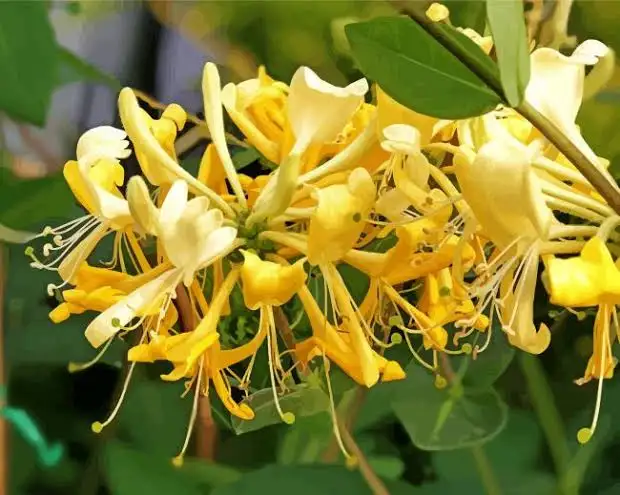
Japanese honeysuckle spreads and climbs very aggressively, smothering low-growing native plant species and girdling small trees and shrubs. Birds help spread seeds by eating the dark berries, but Japanese honeysuckle also reproduces through vigorously spreading rhizomes and runners that can root and grow just about anywhere with moist soil. Evergreen in warmer climates, the vine produces new spring growth before native plants and continues growing after native plants go dormant. Its long growing season, fast growth rate, multiple spreading methods and lack of natural enemies all combine to make the Japanese honeysuckle a fierce competitor against native plant species.
Wisteria Vine
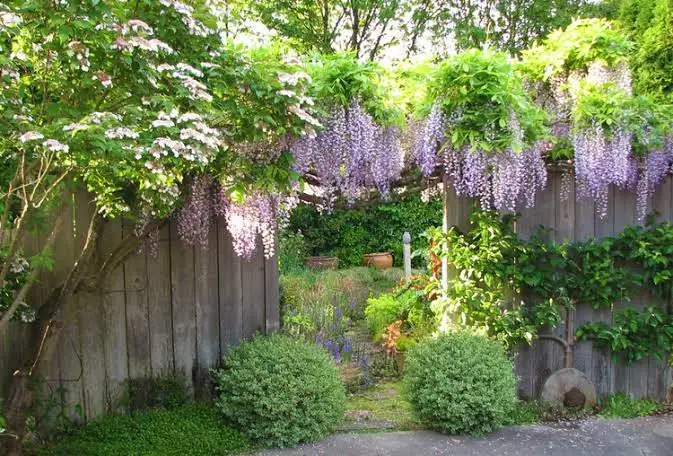
Known for being hardy and long-living, Wisteria climbs very high, twining around supporting structures. The vines have dark green pinnate leaves of nine to 15 leaflets. The plant’s pea-like flowers grow in pendulous clusters and bloom in white and shades of pink, blue and purple. The plant’s seed is a flat green pod that appears after flowers bloom during the spring and summer. The problems associated with allowing wisteria vines to climb up onto a tree is that it’s thick foliage that can shade out the tree, causing it to drop needles prematurely, weakening the tree. The weight of all of those ever-thickening vines high up in the tree, along with the wisteria’s summer foliage, greatly increases the chance of the tree coming down in a windstorm.
Crossvine
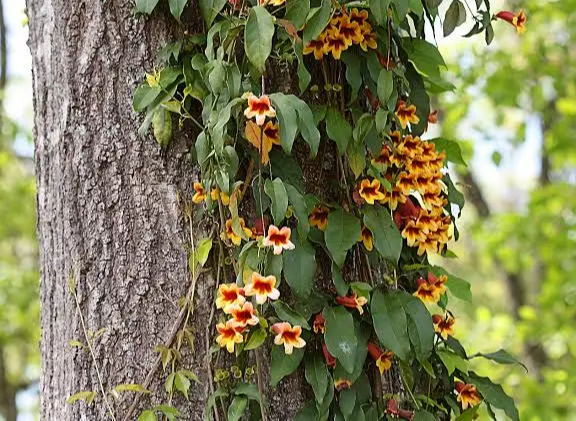
Crossvine (Bignonia capreolata) is a climbing vine with yellow and red flowers that blooms during late spring. Crossvine is a prolific evergreen vine that can climb up to 50 feet in height and reach up to 72 feet in length.
Also Read: Different Types of Ivy
Poison Ivy

Poison ivy grows in alternating clusters of three almond-shaped leaves. The colors vary from light to dark green during the summer, turning mauve red in the fall. Its leaf surfaces are smooth and become shiny with maturity, and the edges may or may not have saw-tooth ridges. Poison ivy vines do not have thorns. Poison ivy flowers in spring and produces dense clusters of off-white berries that ripen from late-summer through fall.
Vanilla pompona

Vanilla pompona is a succulent-stemmed, perennial climbing plant, producing a stem that can be 5 metres or more long. The plant grows into trees, supporting itself by means of aerial roots that are produced from the stem nodes. It is often epiphytic, or becomes epiphytic as the lower portion of the stem withers and dies.
Cuscuta reflexa

Cuscuta reflexa resembles a pile of yellow-orange straw wrapped tightly around its host plant. It is mostly stem; the leaves are reduced to scales on the stem’s surface, since they are not needed for photosynthesis while the dodder is obtaining nutrients from its host. Cuscuta reflexa builds a canopy on the host plant and casts thousands of tendrils to form a dense spectacle before it strangles it, eventually killing it. It is already affecting crops such tomatoes, sweet potatoes, tea, coffee and potatoes.
Also Read: Trees With White Barks
Cuscuta campestris
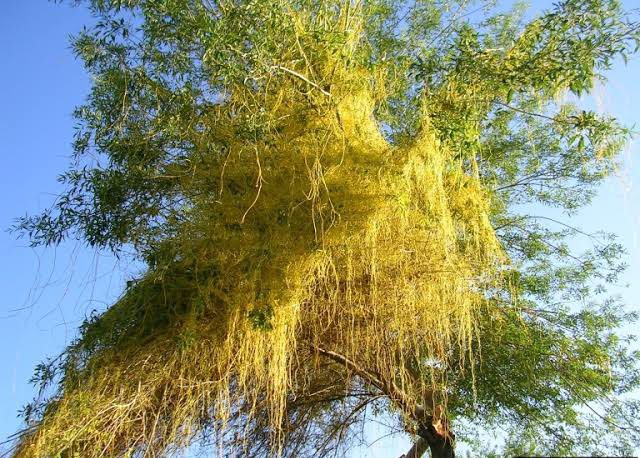
Cuscuta campestris, with the common names field dodder are almost totally dependent on the host plants for nutrition. If a dodder plant is allowed to grow unchecked, it will form dense mats in and over the host plant. Dodder plants branch and re-branch, spreading from plant to plant until large areas may be infested. Stem growth of 7.5 cm per day has been recorded. A single dodder plant may spread to a diameter of 3 m or more.
Mistletoe

Mistletoe is the common name for obligate hemiparasitic plants. They are attached to their host tree or shrub by a structure called the haustorium, through which they extract water and nutrients from the host plant. Mistletoes are a unique group of plants that have long fascinated people, inspiring a prominent role in folklore and mythology. Lacking roots, remaining green and leafy year-round, and even bearing fruit during freezing winters.
Cuscuta gronovii

Cuscuta gronovii is a parasitic annual vine that infects host plants in a parasitic relationship. Its stems appear orange-yellow in color. The vine can grow up to a length of one meter or more, entangling itself around the host plant. Although it appears to be leafless, it has tiny, alternate, scale-like leaves. The vine produces white flowers with bell-shaped, five-lobed corollas, and sepals United at the base. The flowers are roughly 1/8 of an inch apart from one another.
Chaparral dodder

Cuscuta californica is a species of dodder known by the common names chaparral dodder and California dodder. This is an annual parasitic plant that may resemble fine strands of spaghetti or twine strewn across other species in its habitat. A mature plant of this species may fulfill all of its food and water needs from the host plant, but they rarely kill their host.